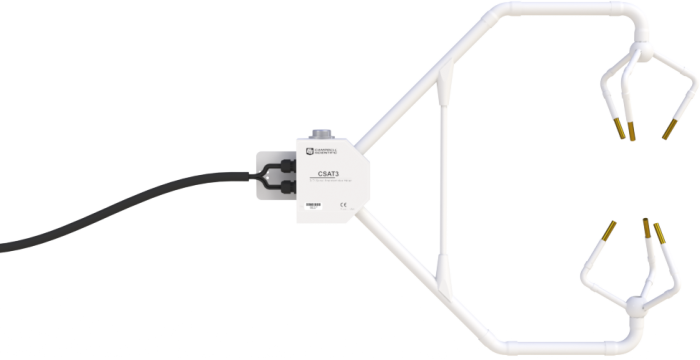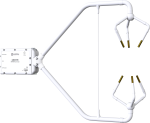This product is not available for new orders. We recommend ordering: CSAT3B.

| Services Available | |
|---|---|
| Repair | No |
| Calibration | Yes |
| Free Support | Yes |
Overview
The CSAT3 is a three-dimensional sonic anemometer that measures three orthogonal wind components and the speed of sound. In eddy covariance systems, it can measure the turbulent fluctuations of horizontal and vertical wind. These measurements are then used to calculate momentum flux and friction velocity. This sonic anemometer can also provide average horizontal wind speed and direction measurements. The CSAT3 comes with 25 ft cables.
Read MoreBenefits and Features
- Provides precision turbulence measurements with minimal flow distortion
- FW05 fine wire thermocouple (12.7 μm diameter) is available as an option for fast response temperature measurements
- Withstands exposure to harsh weather conditions
- Measurements can be used to calculate momentum flux and friction velocity
- Compatible with most Campbell Scientific data loggers
Whenever possible, use the CSAT3B (the CSAT3's replacement) instead.
Images

Detailed Description
The CSAT3 has a 10 cm vertical measurement path and operates in a pulsed acoustic mode. The three orthogonal wind components (ux, uy, uz) and the speed of sound (c) are measured and output at a maximum rate of 60 Hz. Analog outputs and two types of digital outputs are provided.
Measurements can be triggered from from the CSAT3’s internal clock, the PC-generated RS-232 command, or the data logger’s SDM command. The SDM protocol supports a group trigger for synchronizing multiple CSAT3s.
The FW05 fine wire thermocouple (12.7 μm diameter) is available as an option for fast response temperature measurements.
Specifications
| Measurement Path Length |
|
| Path Angle from Horizontal | 60° |
| Construction | Sealed sonic transducers and electronics |
| Anemometer Head Materials | Stainless-steel tubing |
| Electronics Box Materials | Cast aluminum |
| Operating Temperature Range | -30° to +50°C |
| Voltage Supply | 10 to 16 Vdc |
| Current |
|
| Digital SDM Output Signal | CSI 33.3 k baud serial interface for data logger/sensor communication. (Data type is 2-byte integer per output plus 2-byte diagnostic.) |
| Support Arm Diameter | 1.59 cm (0.63 in.) |
| Transducer Diameter | 0.64 cm (0.25 in.) |
| Transducer Mounting Fingers Diameter | 0.84 cm (0.33 in.) |
| Cable Length | 7.62 m (25 ft) |
| Anemometer Head Dimensions | 47.3 x 42.4 cm (18.6 x 16.7 in.) |
| Anemometer Head Weight | 1.7 kg (3.7 lb) |
| Electronics Box Dimensions | 26 x 16 x 9 cm (10.24 x 6.3 x 3.54 in.) |
| Electronics Box Weight | 3.8 kg (8.4 lb) |
Measurements |
|
| Outputs |
ux, uy, uz, c (ux, uy, uz are wind components referenced to the anemometer axes; c is speed of sound.) |
| Speed of Sound | Determined from three acoustic paths; corrected for crosswind effects. |
| Measurement Rate | Programmable from 1 to 60 Hz, instantaneous measurements. Two over-sampled modes are block averaged to either 20 Hz or 10 Hz. |
| Measurement Resolution |
|
| Offset Error |
|
| Gain Error |
|
| Wind Direction Accuracy | ±0.7° at 1 m/s (for horizontal wind) |
| Rain | Innovative ultrasonic signal processing and user-installable wicks considerably improve the performance of the anemometer under all rain events. |
Digital RS-232 Output Signal |
|
| Baud Rate | 9600, 19200 bps |
| Data Type | 2-byte integer per output plus 2-byte diagnostic |
Analog |
|
| Number of Outputs | 4 |
| Voltage Range | ±5 V |
| Number of Bits | 12 |
SDM & RS-232 Digital Outputs Reporting Range |
|
| Full-Scale Wind | ±65.535 m/s autoranging between four ranges (Least significant bit is 0.25 to 2 mm/s.) |
| Speed of Sound | 300 to 366 m/s (-50° to +60°C) Least significant bit is 1 mm/s (0.002°C). |
Analog Outputs Reporting Range |
|
| ux | ±30 m s-1, ±60 m s-1 |
| uy | ±30 m s-1, ±60 m s-1 |
| uz | ±8 m s-1 |
| c | 300 to 366 m s-1 (-50 to +60°C) |
Analog Outputs LSB |
|
| ux | 15 mm s-1, 30 mm s-1 |
| uy | 15 mm s-1, 30 mm s-1 |
| uz | ±8 m s-1 |
| c | 16 mm s-1 (0.026°C) |
Compatibility
Note: The following shows notable compatibility information. It is not a comprehensive list of all compatible or incompatible products.
Data Loggers
| Product | Compatible | Note |
|---|---|---|
| 21X (retired) | ||
| CR10 (retired) | ||
| CR1000 (retired) | ||
| CR10X (retired) | ||
| CR200X (retired) | ||
| CR206X (retired) | ||
| CR211X (retired) | ||
| CR216X (retired) | ||
| CR23X (retired) | ||
| CR295X (retired) | ||
| CR300 (retired) | ||
| CR3000 (retired) | ||
| CR500 (retired) | ||
| CR5000 (retired) | ||
| CR510 (retired) | ||
| CR6 | ||
| CR800 (retired) | ||
| CR850 (retired) | ||
| CR9000 (retired) | ||
| CR9000X (retired) |
Additional Compatibility Information
Data Logger Considerations
Required Operating Systems or PROMs
| Data Logger Model | Data Logger Operating System (OS) or PROMs Required |
CSAT3 OS Required |
| 21X | 1K 6145-3, 6146-5, 10006-1 | 2.1 or higher |
| 21X | 2K 6148-5, 6149-7, 6070-64 | 2.1 or higher |
| CR800, CR850 | All OS | 3.0 or higher |
| CR10 | 2K 5954-396; 4K is a Library Special |
2.1 or higher |
| CR10X | OS 1.4 or higher | 2.1 or higher |
| CR1000 | All OS | 3.0 or higher |
| CR23X | All OS | 2.1 or higher |
| CR3000 | All OS | 3.0 or higher |
| CR5000 | All OS | 3.0 or higher |
| CR9000 | 2.01 or higher | 2.1 or higher |
| CR9000X | All OS | 2.1 or higher |
Documents
Downloads
CSAT3 (567 KB) 24-03-1998
PC support software for monitoring and configuring the CSAT3.Frequently Asked Questions
Number of FAQs related to CSAT3: 10
Expand AllCollapse All
-
The CSAT3/3A/3AH calibration applies a correction for transducer delay over temperature. Transducer delays cause an offset in the wind speed measurement, and to a lesser extent, an offset in the speed of sound measurement.
The CSAT3/3A/3AH speed of sound easement is corrected for the effects of wind blowing normal to the sonic path.
-
The CSAT3 can be mounted on the end of a CM202, CM203, CM204, or CM206 crossarm, using the included CM250 Leveling Mounting Kit. Alternatively, the CSAT3 can mounted to a flat horizontal surface using a 3/8-16 stainless-steel bolt.
-
No. The CSAT3/3A/3AH is a sensor. Time stamps are assigned to the sonic anemometer data by the data-acquisition system—typically a Campbell Scientific data logger or PC.
-
Yes. The bubble level can be replaced in the field using pn 31962, 1-Ring Replacement Bubble Level with Mounting Bumper and Hardware.
-
The CSAT3/3A/3H is compatible with three output signals: analog, RS-232, and Synchronous Device for Measurement (SDM). The sonic anemometer can be interfaced to any data-acquisition system that is compatible with analog measurements or RS-232 serial communications. SDM is used with Campbell Scientific data loggers.
-
The sensors used in the eddy-covariance application are not compatible with SCWin. An open-path eddy-covariance program is available for purchase as pn 18442, CRBasic Basic Eddy Covariance Program. This is the program without energy balance sensors. Also available is pn 18443, CRBasic Extended Eddy Covariance Program, with energy balance sensors. To order a custom configured program, contact the Environmental Group for assistance.
-
Yes. The CSAT3 electronics contain unique calibration and sensor head geometry information. The sensor head and electronics are a matched set. (The serial number on the sensor head must match the electronics to make valid measurements.)
-
With long cable lengths, monitor the SDM data collected from the CSAT3. If the CSAT3 diagnostic word is 61441 or NAN, there are SDM communications errors. If the SDM bit period is increased, SDM communications should be restored. Use the SDMSpeed() instruction to change the SDM bit period. Use the following values for the listed data loggers:
- CR3000: 50
- CR800, CR850, or CR1000: 100
- CR5000: 90
-
The CSAT3/3A/3AH should not be used to measure absolute sonic temperature. Aside from the effects of water vapor in the sonic path, the speed of sound measurement is highly dependent on the ability of the sonic anemometer to maintain its geometry. A 0.2 mm change in the sonic path is equal to a 1°C change in the measured absolute sonic temperature at 25°C. This is equal to a 0.33% error in the absolute sonic temperature. The wind speed measurements are also dependent on the sonic path distance, but to a lesser degree.
-
Sensible heat flux is defined as the covariance of vertical wind and temperature fluctuations, measured with fast-response sensors. For more information, refer to a micrometeorology textbook.
Case Studies
The cultivation of rice—the staple food for India, as well as for approximately half the......read more
On March 14, 2016, the European Space Agency (ESA) launched the first mission in the......read more
Understanding the exchanges of energy, water, and carbon dioxide between the atmosphere, land, and plants......read more
With instrumentation and help from Campbell Scientific, personnel from the Department of Atmospheric Sciences at......read more
Privacy Policy Update
We've updated our privacy policy. Learn More
Cookie Consent
Update your cookie preferences. Update Cookie Preferences








